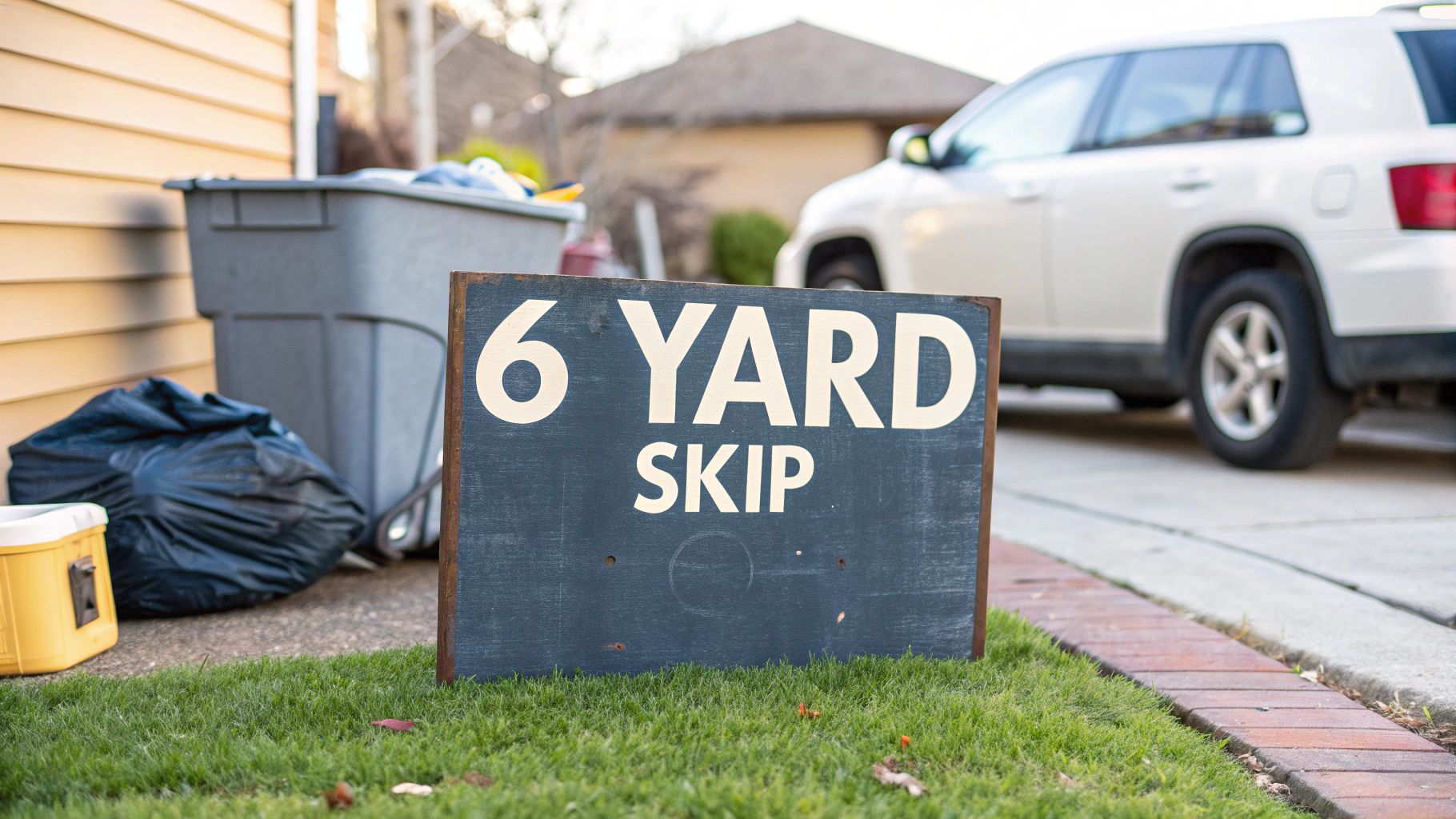Asbestos Disposal Near Me A UK Homeowner Guide
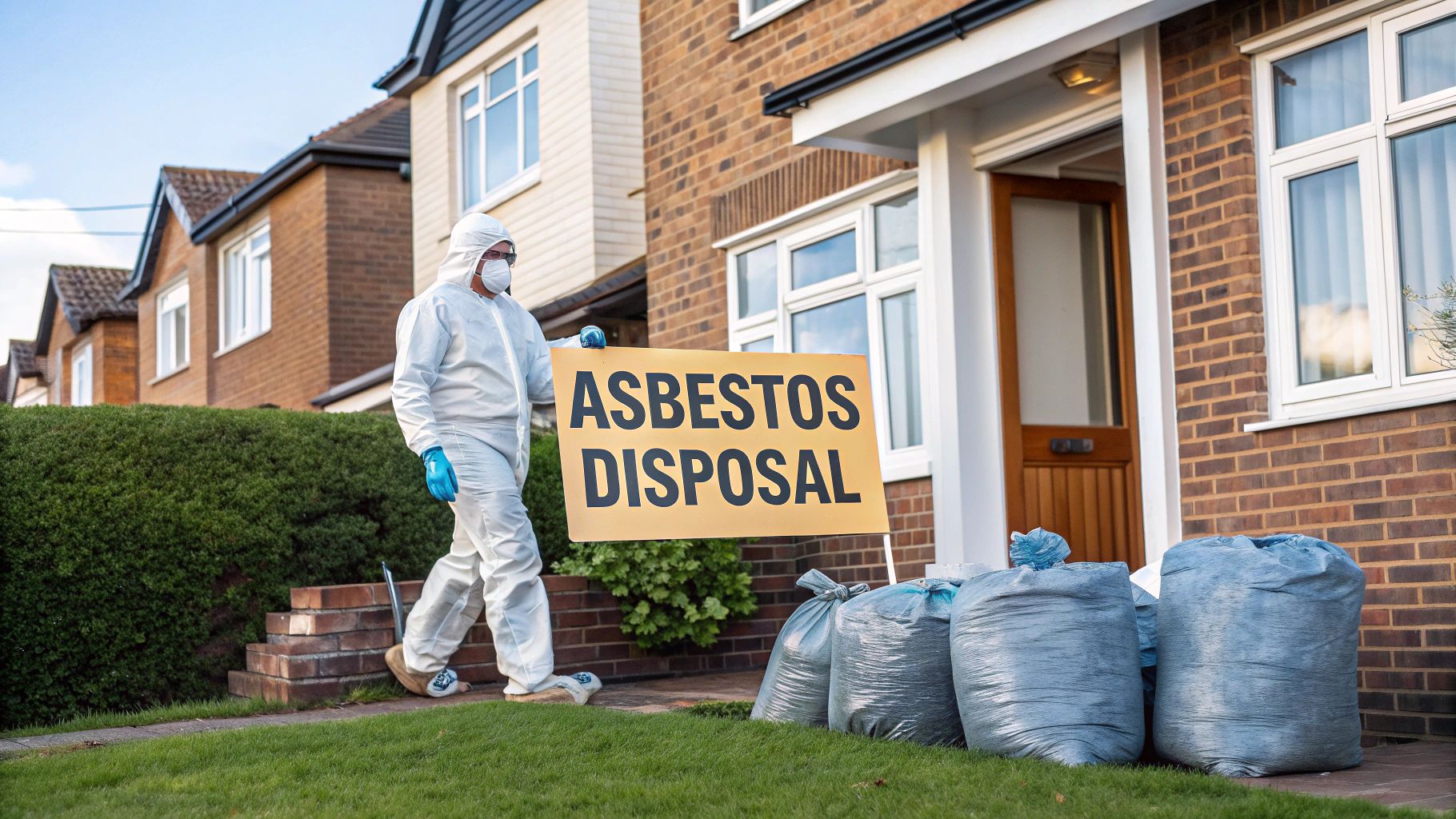
Asbestos Disposal Near Me A UK Homeowner Guide
Finding what you think might be asbestos in your home can be a heart-stopping moment. The first question that always springs to mind is, “How on earth do I find safe asbestos disposal near me?”
Before you do anything else, know this: you absolutely cannot just pop it in the car and take it to the local tip. In the UK, professional handling is mandatory for nearly all types of asbestos, and for very good reason. The health risks are severe.
Your First Steps for Safe Asbestos Disposal
Discovering potential asbestos is unsettling, but a calm, measured approach is your best friend here. The urge to just get rid of it yourself is understandable, but it’s not just dangerous—it’s often illegal. UK regulations are strict to protect you, your family, and the public from those hazardous microscopic fibres.
So, your first real step isn’t about removal. It’s about understanding what you’re dealing with. The law treats different types of asbestos-containing materials (ACMs) differently, and this will dictate your next move.
Bonded vs Friable Asbestos
The main thing you need to know is whether the asbestos is bonded or friable.
- Bonded (Non-Friable) Asbestos: This is where asbestos fibres are locked tightly into another material, like cement or vinyl. Think of old garage roof sheets, certain floor tiles, or even textured coatings like Artex. They’re generally considered lower risk, but only as long as they are left completely alone and are in good condition.
- Friable Asbestos: This is the much more dangerous type. It’s soft and crumbly, and can be broken up by hand, which easily releases fibres into the air. This includes materials like asbestos insulation board (AIB), old pipe lagging, and some sprayed coatings. Friable asbestos always requires a licensed specialist for removal. No exceptions.
Here’s the critical takeaway: Any action that disturbs or damages an asbestos-containing material—drilling, sawing, sanding, or even just breaking it—can turn lower-risk bonded asbestos into a high-risk friable material in an instant. This is precisely why a DIY approach is never recommended.
Knowing this helps you assess the situation from a safe distance. An old, intact cement sheet on a shed roof is one thing. But if that same sheet is cracked and broken, or you spot flaky, decaying insulation around your pipes, the hazard level shoots up dramatically.
Despite the UK banning asbestos back in 1999, it’s far from a problem of the past. It’s estimated that over 1.5 million buildings in the UK still contain asbestos, which shows just how big the challenge of safe removal still is.
For a deeper dive into the full disposal journey, you can learn more about how to dispose of asbestos safely in our comprehensive article.
Common Asbestos Materials and Recommended Disposal Actions
Spotting potential asbestos can be tricky, as it was used in so many common building products. This quick-reference guide should help you identify materials you might find around a typical UK home and understand the right course of action.
| Asbestos-Containing Material (ACM) | Typical Location in Home | Risk Level | Recommended Disposal Route |
|---|---|---|---|
| Asbestos Cement Sheets | Garage/shed roofs, wall panels, gutters | Low (if intact) | Licensed professional removal is safest. Some councils offer limited collection for very small, correctly wrapped amounts. |
| Artex & Textured Coatings | Ceilings, walls (pre-2000) | Low (if intact) | Do not sand or scrape. Leave in place or have professionally removed before major renovation. |
| Vinyl Floor Tiles | Kitchens, bathrooms, hallways | Low (if intact) | Leave in place if possible. Professional removal is required if tiles are damaged or during refurbishment. |
| Asbestos Insulation Board (AIB) | Partition walls, ceiling tiles, soffits | High (Friable) | Licensed professional removal is mandatory. Do not touch or disturb. |
| Pipe Lagging & Insulation | Boiler pipes, heating systems | High (Friable) | Licensed professional removal is mandatory. This is one of the most dangerous forms of asbestos. |
Ultimately, just looking at a material isn’t enough to be 100% certain. If you have any suspicion at all, the only truly safe and reliable step is to call in a certified asbestos professional for testing and advice. It’s the only way to get complete peace of mind.
Why UK Asbestos Laws Are So Strict
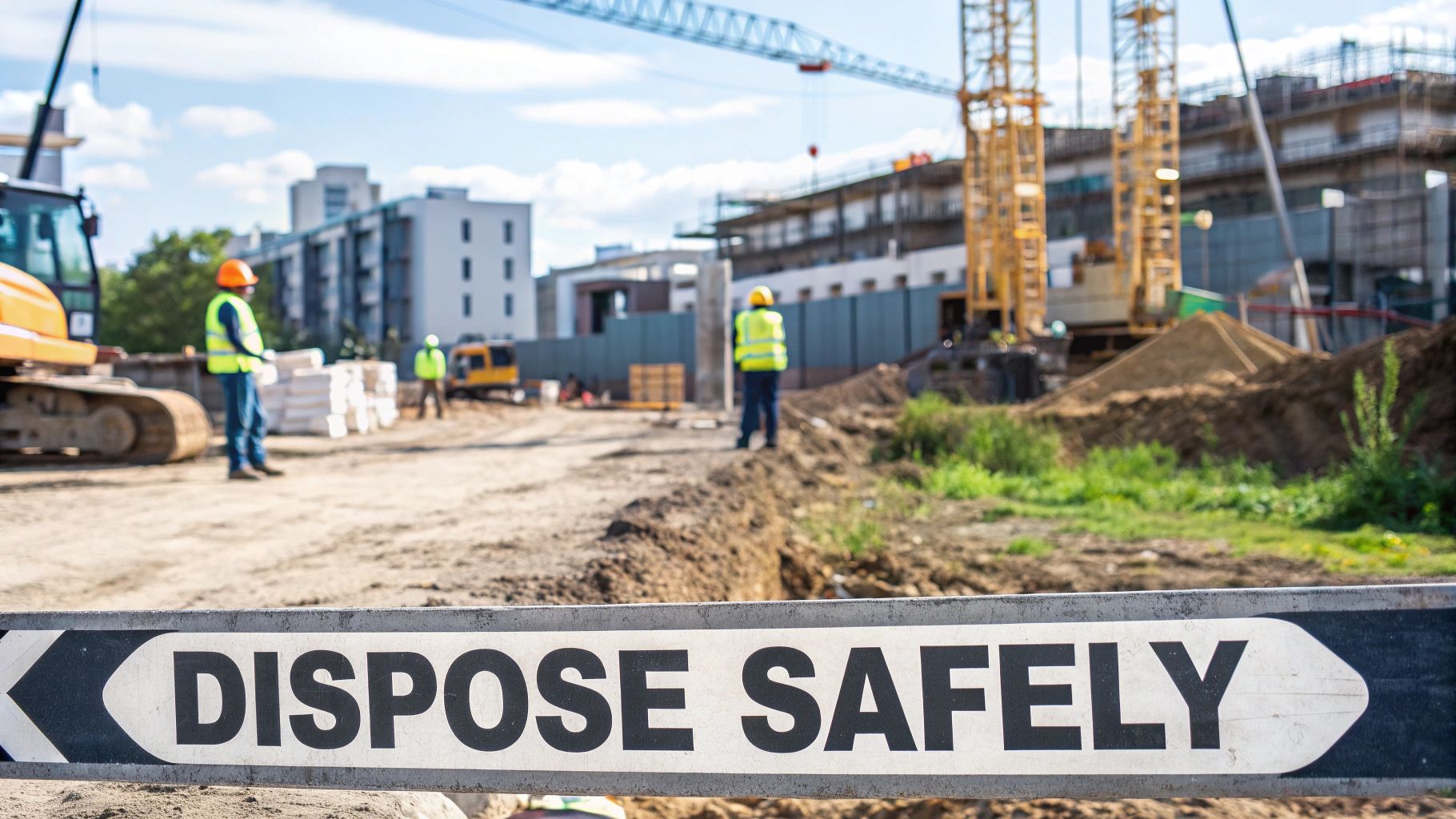
When you’re searching for “asbestos disposal near me,” the maze of regulations can feel like a real headache. But the UK’s asbestos laws aren’t just bureaucracy for its own sake; they are a direct response to a devastating public health crisis that continues to affect thousands of families every single year.
These strict rules exist for one simple reason: to prevent you, your family, and the public from being exposed to microscopic fibres that cause incurable, life-threatening diseases. Understanding the ‘why’ behind it all is the first step in appreciating why calling in the professionals is the only safe and legal path forward.
The Hidden Danger of Asbestos Exposure
The real danger with asbestos is its incredibly long latency period. This means the devastating health effects of breathing in asbestos fibres might not show up for decades after the initial exposure. It’s a silent threat that can have fatal consequences long after the memory of a simple DIY job has faded.
When materials containing asbestos are disturbed—even slightly—they can release thousands of invisible fibres into the air. Once you breathe them in, these tiny, needle-like particles can get stuck permanently in your lungs and other tissues, leading to serious illnesses down the line.
- Mesothelioma: A rare and aggressive cancer that primarily affects the lining of the lungs. It is almost always caused by asbestos exposure.
- Asbestosis: A chronic lung disease that comes from the scarring of lung tissue by asbestos fibres, which causes severe and debilitating shortness of breath.
- Asbestos-Related Lung Cancer: Being exposed to asbestos massively increases the risk of developing lung cancer, and that risk is even higher for smokers.
The tragedy is that many people were exposed decades ago without ever knowing the risk. This huge delay between exposure and illness is why the UK still faces such a massive public health challenge today, even though all types of asbestos were finally banned back in 1999.
The legacy of past exposure is stark. Asbestos-related diseases are still a major issue in the UK, with the latency period for these illnesses ranging from 15 to 60 years. In 2023 alone, there were 2,218 deaths from mesothelioma, with total deaths from all asbestos-related diseases topping 5,000 annually. You can explore more on Britain’s ongoing struggle with asbestos on ibasecretariat.org.
This sobering reality is the foundation for every single piece of legislation governing how asbestos is managed and disposed of.
Understanding Key UK Asbestos Legislation
The central piece of law you need to know about is the Control of Asbestos Regulations 2012. While a lot of it applies to commercial properties and employers, its principles are there to protect everyone, including homeowners.
This regulation places a legal responsibility on those who manage non-domestic premises to protect people from asbestos risk. It’s known as the ‘duty to manage’. For homeowners, while you don’t have the same strict legal duty, the regulations set the gold standard for safety. Any professional you hire must adhere to these rules.
A crucial part of these regulations covers how asbestos waste is disposed of. It’s classified as hazardous waste and absolutely cannot be mixed with your regular rubbish or chucked in a standard local tip. The rules are designed to track the asbestos from your property all the way to a licensed disposal site, ensuring it doesn’t pose a threat to anyone else along the way.
How the Law Impacts Your Disposal Choices
This strict legal framework directly shapes your options for asbestos disposal. It’s the reason you can’t just hire a general builder or a “man with a van” for a cheap cash-in-hand deal. It’s a risk not worth taking.
Here’s what the law demands from any legitimate service:
- Correct Licensing: The contractor must hold a specific licence from the Health and Safety Executive (HSE) to work with most types of asbestos.
- Safe Removal Practices: They have to use controlled methods, like wetting down materials and creating sealed enclosures, to stop fibres from getting into the air.
- Proper Packaging: All asbestos waste must be double-bagged in UN-approved, clearly labelled red and clear asbestos sacks. No exceptions.
- Legal Transport: The waste has to be moved by a carrier with a hazardous waste licence.
- Official Documentation: You must be given a Waste Consignment Note. This is your legal proof that the asbestos was handled and disposed of correctly at a licensed facility.
Without this complete chain of custody, you have zero proof of legal disposal and could even be held liable if the waste gets fly-tipped. The strictness of these laws is ultimately for your protection, ensuring the job is done right and taking all the risk and worry off your shoulders.
How to Find and Vet Certified Asbestos Professionals
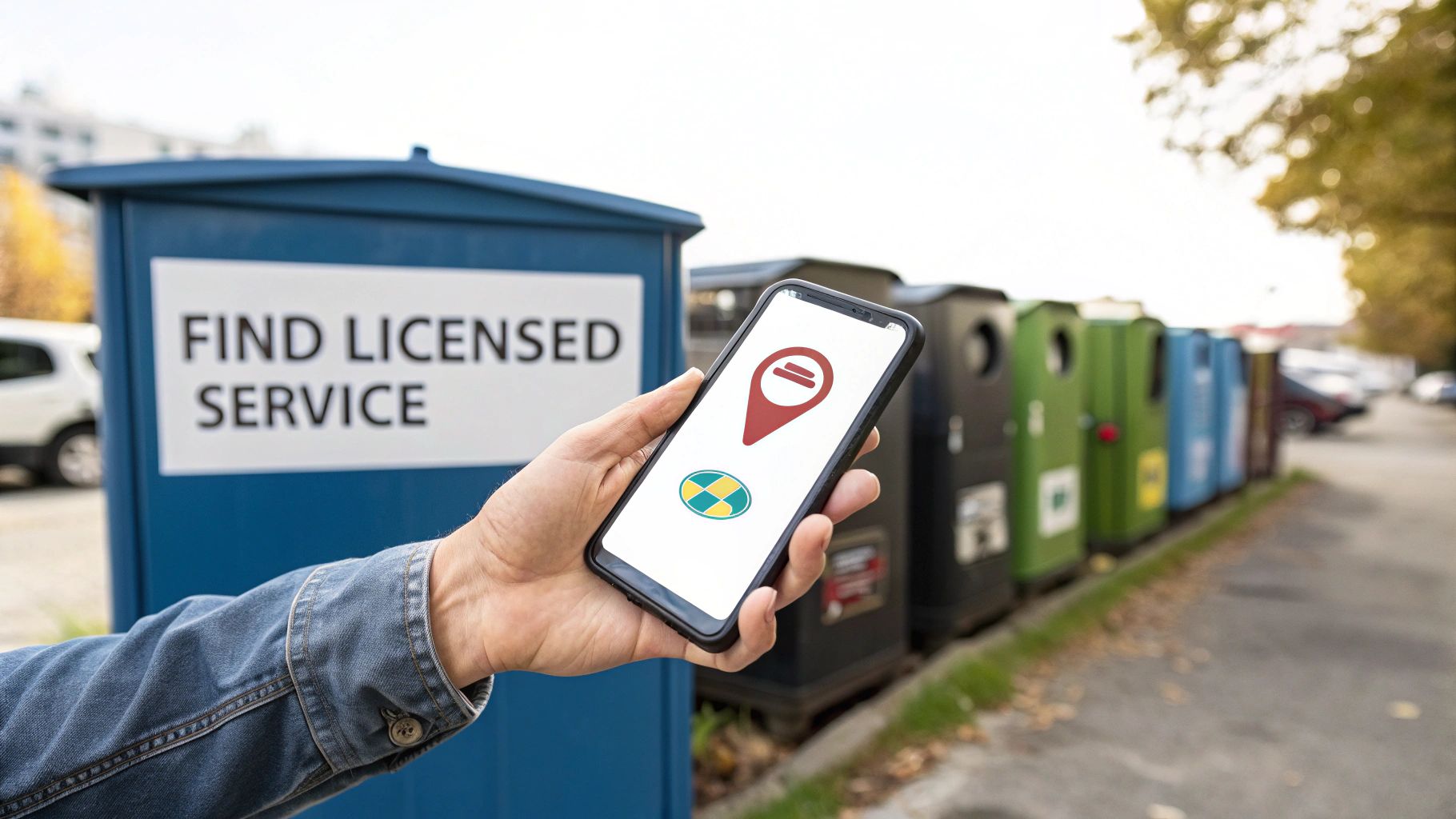
Once you realise just how strict the laws and serious the risks are, finding the right people for the job becomes your top priority. A quick online search for “asbestos disposal near me” will throw up a lot of options, but how do you sort the genuine experts from the risky cowboys?
Hiring the wrong company isn’t just a waste of money. It can put your family’s health in jeopardy and leave you in a heap of legal trouble.
Vetting a potential contractor is about more than just glancing at a few online reviews. It means knowing where to look for accredited professionals and which critical questions to ask to make sure they’re competent, insured, and fully compliant with UK law. This is your essential checklist for finding a company you can actually trust.
Start with Official Directories
Instead of just relying on Google, your first port of call should always be the official industry bodies. These organisations keep updated lists of members who are regularly audited and have to stick to strict codes of conduct. This simple step immediately weeds out the unqualified operators.
A key resource in the UK is the Asbestos Removal Contractors Association (ARCA). Their member list is the gold standard for finding licensed professionals you can count on. Similarly, organisations like the Independent Asbestos Training Providers (IATP) can point you toward companies whose staff have the right, up-to-date training. Using these directories gives you a pre-vetted list of contractors in your area.
For a more detailed look at what makes a good choice, our guide on how to choose the right asbestos removal company offers even more specific insights.
Expert Tip: Don’t just take a company’s word for it when they claim to be an ARCA member. Always cross-reference their business name on the official ARCA website to confirm their membership is current and valid. A little check goes a long way.
Crucial Questions to Ask Every Contractor
Once you’ve got a shortlist, it’s time to pick up the phone. The way a company answers the following questions will tell you everything you need to know about their professionalism and legitimacy. A reputable firm will welcome these questions and answer them clearly and confidently.
Essential Vetting Checklist
- “Are you licensed by the Health and Safety Executive (HSE)?” For most asbestos removal (anything beyond non-licensed materials), an HSE licence is a legal must-have. Ask for their licence number and don’t be afraid to verify it.
- “Can you provide proof of your insurance?” They absolutely must have specific public liability insurance that explicitly covers asbestos work. Your standard builder’s insurance won’t cut it.
- “Will I receive a waste consignment note?” This is non-negotiable. This note is your legal proof that the asbestos was disposed of correctly at a licensed facility. If they hesitate or say it isn’t necessary, end the conversation right there.
- “How will you contain the work area?” A real pro will be able to walk you through their methods for sealing the area, using negative air pressure units, and setting up decontamination zones to stop fibres from escaping into the rest of your home.
- “Do all your operatives have up-to-date training and medical certificates?” Every single worker on site must be properly trained and medically fit for asbestos work. This shows a serious commitment to safety and following the rules.
Spotting the Red Flags
Knowing what to look for is one thing, but recognising the warning signs of a rogue trader is just as important. These red flags should make you immediately reconsider, no matter how tempting their price might be.
A suspiciously low quote is often the biggest giveaway. Proper asbestos disposal is a complex process with significant costs for equipment, insurance, training, and legal disposal fees. An estimate that massively undercuts everyone else almost certainly means they’re cutting dangerous corners.
Refusing to provide documents is another huge warning. If a contractor is cagey about showing you their HSE licence, insurance certificate, or a sample waste consignment note, it’s a clear sign they have something to hide.
Finally, be wary of anyone who pushes for a cheap cash-in-hand deal or suggests illegally dumping the waste to “save money”. This not only puts you at risk but could also make you liable for massive environmental fines. Your peace of mind is worth far more than any savings from a dodgy deal.
What to Expect During Professional Asbestos Disposal
Deciding to hire professionals for asbestos disposal gives you massive peace of mind, but it definitely helps to know what the process actually involves. When you understand the steps, it takes away a lot of the anxiety and confirms you’ve made the right decision.
So, let’s walk through a typical job—say, removing an old asbestos cement garage roof—to show you what a safe, legal, and professional project looks like from start to finish.
A proper asbestos disposal job follows strict, detailed safe work procedures to make sure every single step is carried out without risk. It’s a carefully planned operation, not just a quick demolition job. The whole process is designed to protect you, your property, and the specialists themselves.
Site Preparation and Containment
Before anyone even thinks about touching the asbestos-containing materials (ACMs), the number one priority is to completely secure the area. This is a lot more than just putting up some warning tape; it’s a critical containment process.
For our garage roof example, the team will start by creating a sealed exclusion zone around the whole structure. This usually involves using heavy-duty polythene sheeting to seal off any doorways, windows, or other openings. The goal is to stop any fibres from escaping into your garden or, worse, your home. They’ll also put up clear warning signs to let anyone nearby know that asbestos removal is underway.
Key Insight: A crucial part of this setup is often air monitoring. The professionals may use specialised equipment to test the air before, during, and after the job. This provides scientific proof that their containment methods are working and that no dangerous fibres have been released into the environment.
Careful Removal and Wetting Techniques
Once the area is fully contained, the removal can begin. This is a delicate process. The golden rule is to minimise fibre release, and the main technique used for this is something called ‘wetting down’.
Contractors will spray the asbestos cement sheets with a fine water mist that’s been mixed with a special surfactant. This helps the water soak right into the material instead of just running off. It’s a simple but vital step that ensures if any fibres do break loose during removal, they’re captured by the moisture and can’t become airborne.
They will then painstakingly unbolt and remove the sheets whole, avoiding breaking or shattering them at all costs. This is worlds away from the sledgehammer approach a general builder might take. Every single movement is controlled and deliberate.
This infographic breaks down the core stages of the professional disposal journey.
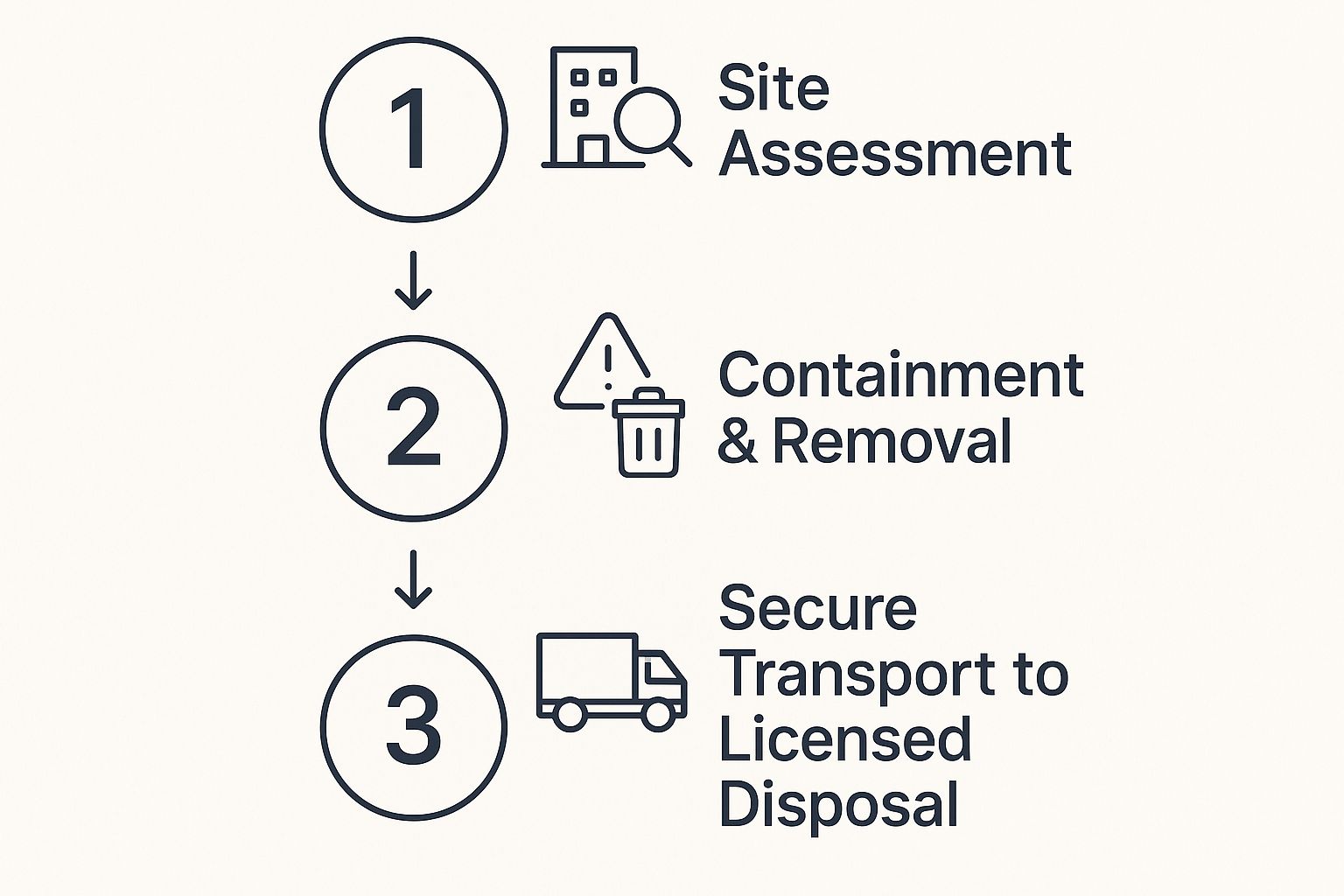
As you can see, the entire process is a structured sequence designed for maximum safety, from the initial assessment right through to the final, documented disposal.
Packaging and Transport
As each sheet comes off the roof, it’s immediately taken to a designated bagging area inside the sealed zone. The packaging requirements are extremely strict under UK law.
- Initial Wrapping: First, the ACMs are wrapped in a heavy-duty, red asbestos bag that is clearly marked with the statutory asbestos warning label.
- Double Bagging: This red bag is then placed inside a second, larger clear bag, which is also labelled. This double-bagging method provides an extra layer of protection against any rips or leaks.
- Secure Sealing: Both bags are then securely sealed with strong tape to create a completely airtight package.
After all the materials are safely bagged, the team will decontaminate the work area. This often involves using special HEPA-filter vacuums designed specifically for asbestos dust. Only then is the waste moved to their licensed vehicle, which must be suitable for transporting hazardous waste and driven by a properly trained operator.
The final leg of the journey is to a licensed hazardous waste transfer station or landfill. Upon arrival, the facility weighs the waste and completes the final section of the waste consignment note. Your contractor will then give you a copy of this completed document. This is your absolute legal proof that your asbestos waste was handled and disposed of safely and in full compliance with UK law.
Breaking Down Asbestos Disposal Costs and Council Options

Let’s get straight to the point. When you discover an asbestos problem, one of the first things you’ll ask is, “How much is this going to set me back?” It’s a perfectly sensible question, and understanding the costs involved is key to planning and avoiding any nasty surprises down the line.
The final bill for professional asbestos removal isn’t just a number pulled out of thin air. It’s a careful calculation based on several factors, and no two jobs are ever quite the same.
The quote you receive will boil down to three main things:
- Type of Asbestos: As we’ve mentioned, friable asbestos (the crumbly stuff like insulation board) is far more dangerous to tackle than bonded asbestos (like solid cement sheets). The higher risk means more complex safety protocols, and that, naturally, bumps up the cost.
- Amount of Waste: This one’s simple – the more asbestos you have, the more it costs to get rid of. Disposal facilities charge by weight, so clearing a few roof panels will be much cheaper than disposing of an entire garage.
- Accessibility: Is the asbestos tucked away in a cramped loft or high on a roof? Awkward spots often need more time, specialised gear like scaffolding, and extra labour, all of which will be factored into the price.
Typical Costs for Common Jobs
So, what does this look like in the real world? To give you a rough idea, removing an asbestos roof from a single garage typically costs around £550 plus VAT. If you need the entire garage demolished and removed (walls and roof), you’re looking at an average of about £1,400 plus VAT.
Tackling an Artex ceiling is another common job, and the price can vary from £300 to £1,200, with most homeowners paying around £1,000 plus VAT, depending on the size of the room.
For a more detailed look at potential costs for different clean-up projects, tools like this Environmental Remediation Cost Estimator can be a really useful starting point.
Can Your Local Council Help?
It’s a question we get all the time: will the local council help with asbestos disposal? A few years ago, many councils did offer a collection service for small amounts of household asbestos. But with tighter budgets and stricter regulations, these services are now few and far between.
While it’s no longer a widespread option, it doesn’t hurt to check. A handful of councils might still provide a limited, subsidised collection, but be prepared for some very strict conditions.
Important Note: If your council does offer a service, it will almost certainly be for small amounts of bonded asbestos cement from a residential home. They won’t touch friable asbestos or handle large-scale removal jobs.
Checking Your Council’s Policy
If you’re only dealing with a tiny amount of asbestos cement—say, a single, unbroken sheet—it’s worth seeing what your local council’s policy is.
Here’s the best way to go about it:
- Check Their Website: Your first stop should be your local council’s website. Use the search bar for terms like “asbestos disposal,” “hazardous waste,” or “cement sheet collection.”
- Look for Specific Rules: If they have a service, read the rules carefully. They will have very precise instructions on how the material must be double-wrapped and sealed. You’ll almost certainly need to buy the special asbestos disposal bags yourself.
- Check for Fees and Booking: Even a subsidised service will usually have a fee. You’ll also need to book a collection date, often well in advance, as they don’t offer an on-demand service.
At the end of the day, while it’s worth a quick check with the council for very minor situations, it’s rarely a practical solution for most asbestos issues. For anything more than a tiny piece of bonded material, calling in a professional, licensed contractor is the safest—and only guaranteed legal—way forward.
Frequently Asked Asbestos Disposal Questions
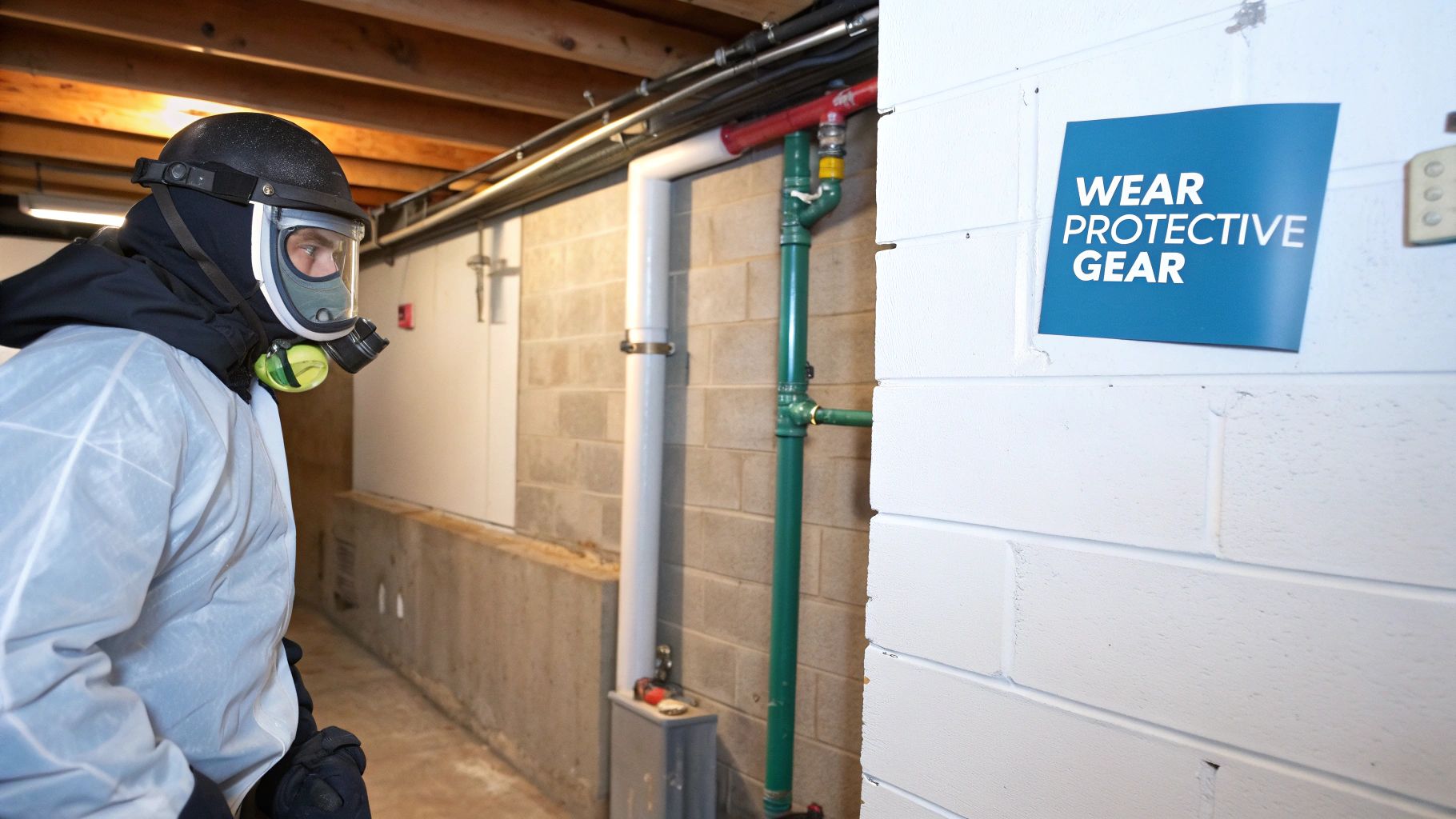
Even with a good grasp of the risks and rules, real-world questions always pop up when you’re actually facing an asbestos problem. When you find yourself searching for “asbestos disposal near me,” you need clear answers, not confusing jargon.
This is where we cut through the noise. We’ll tackle those specific, nagging queries head-on, giving you the straightforward advice you need to handle these situations with confidence.
Can I Take a Small Piece of Asbestos to My Local Tip?
In short, the answer is almost certainly no. Your local household waste recycling centre just isn’t licensed to handle hazardous materials like asbestos. Trying to sneak it in with your garden waste or general rubbish isn’t just dangerous—it’s illegal. You’d be putting waste handlers and the public at serious risk.
A tiny handful of councils might have a special facility or a very limited collection service for bonded asbestos (like hard cement sheets). But this isn’t something you can just do on a whim. You’ll need to book it weeks in advance and follow their packaging instructions down to the very last detail. Never, ever just turn up. Your first port of call should always be your local council’s website to check their specific rules.
Should I Accept a Cheap Cash Deal from a Builder?
You should be incredibly cautious of any offer like this. A general builder, roofer, or a ‘man with a van’ is not a licensed asbestos professional. To legally handle, transport, and dispose of most asbestos, a company needs a special licence from the Health and Safety Executive (HSE).
A bargain-basement price is a huge red flag. It usually means they’re cutting corners on safety gear and correct procedures. Worse still, it’s a near-guarantee that the asbestos will be fly-tipped illegally. If that waste is traced back to your property, you could be the one facing prosecution. Always use a certified specialist.
A cheap deal for asbestos removal is never a bargain. The potential cost to your health and the legal ramifications of illegal disposal far outweigh any initial savings. A reputable professional will never offer a cash deal that bypasses legal documentation.
What Is a Waste Consignment Note?
This is a legal document you absolutely must have. Think of it as a passport for hazardous waste. It tracks the asbestos from the moment it’s removed from your property all the way to its final, safe disposal at a licensed facility.
This note is your official, legally-binding proof that the job was done correctly according to UK law. It has to be filled out and signed by three parties:
- The producer (you or your contractor)
- The carrier (the transport company)
- The final disposal site operator
Any professional contractor will give you a copy of the completed note without you even having to ask. If a company can’t or won’t provide one, walk away. It means you have zero proof of proper disposal and could be held liable if it’s dumped illegally. For more context on the dangers involved, take a look at our article on asbestos-related diseases and health risks.
What Should I Do with Just One Small Sheet?
If you’ve found a single, unbroken sheet of bonded asbestos cement, your first move is to check your local council’s website. They might offer a special, subsidised collection for small amounts from homes, but you’ll have to follow their strict wrapping and collection rules precisely.
If your council doesn’t offer this, or if the sheet is cracked, broken, or damaged in any way, you must call in a licensed professional. It’s not worth the risk. Don’t be tempted to break it up to fit in a bin bag. Even for a tiny job, using a pro service ensures it’s handled, packaged, and disposed of safely, removing all risk and legal headaches from your shoulders.
At The Waste Group, we provide fully compliant, professional asbestos disposal services to give you complete peace of mind. Our licensed team handles everything safely and legally, ensuring you receive all the necessary documentation. Contact us today for a safe and responsible solution.
Article created using Outrank
